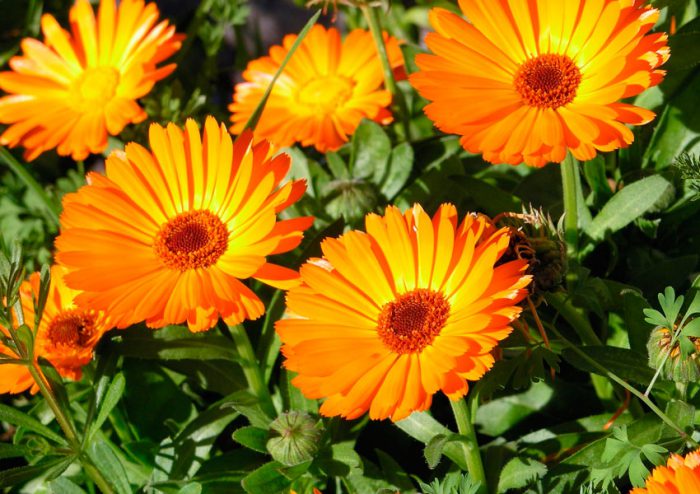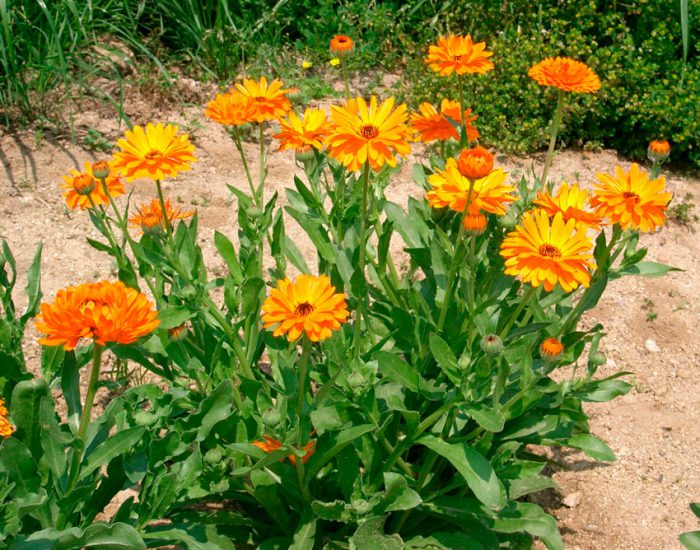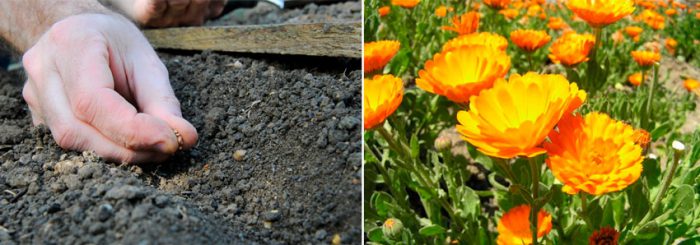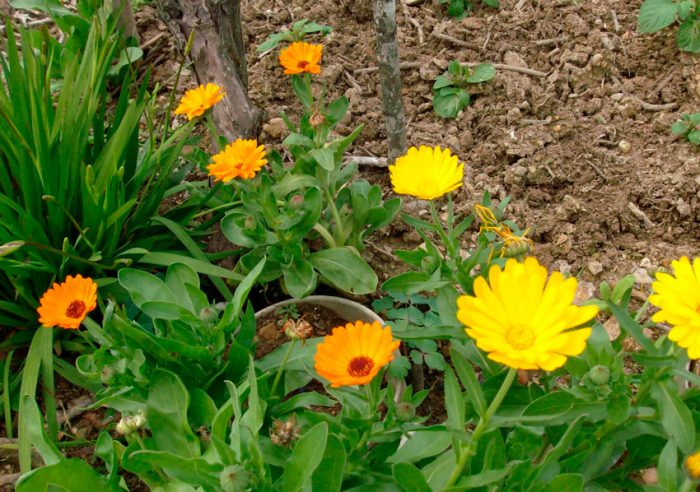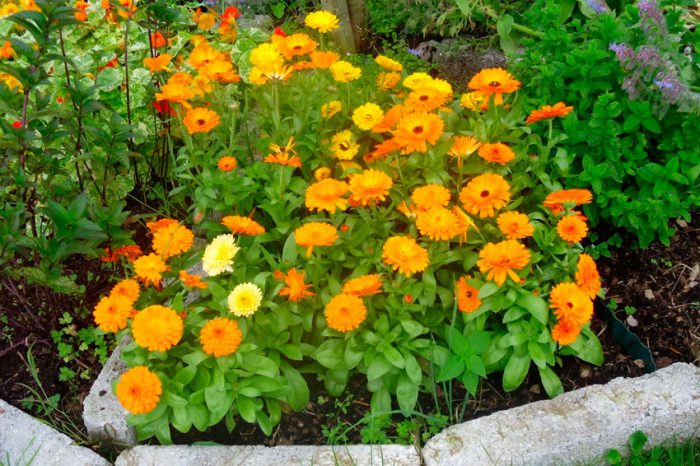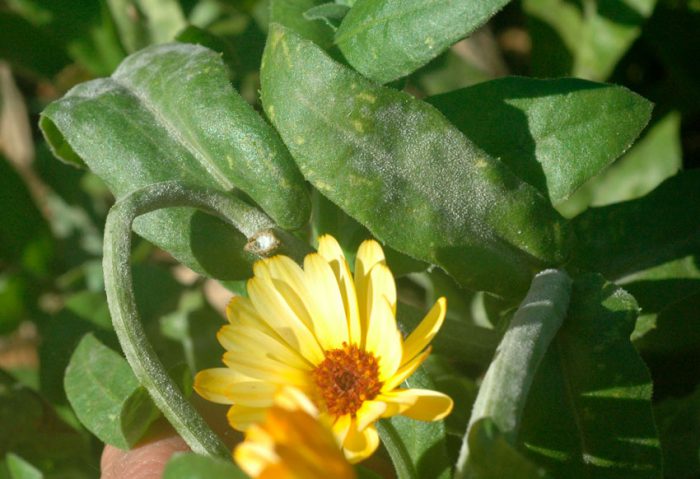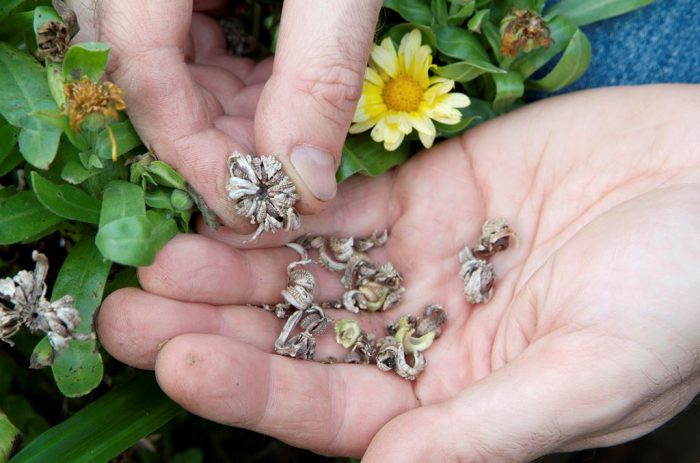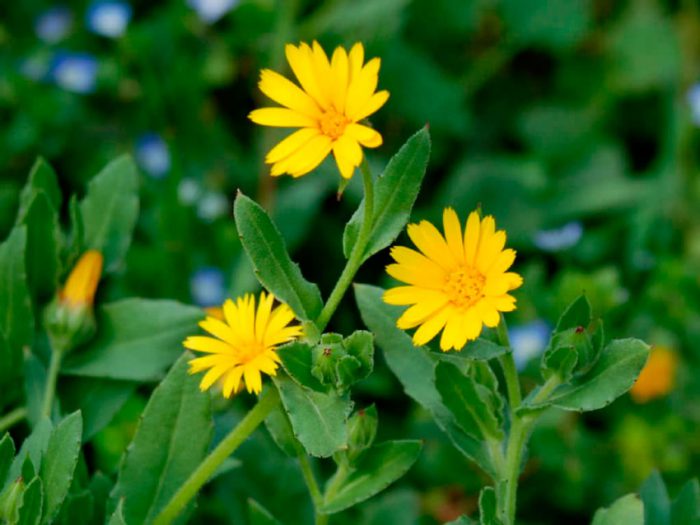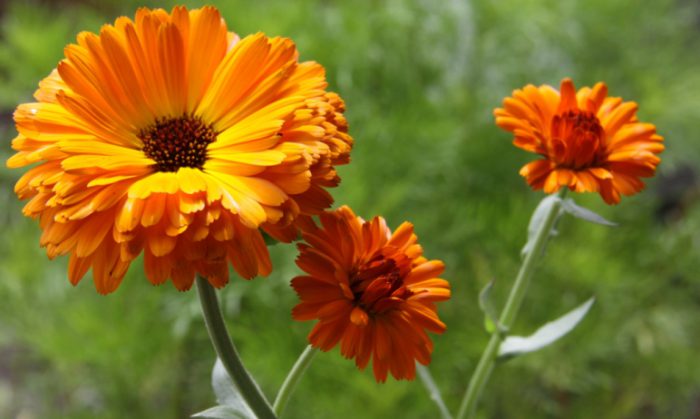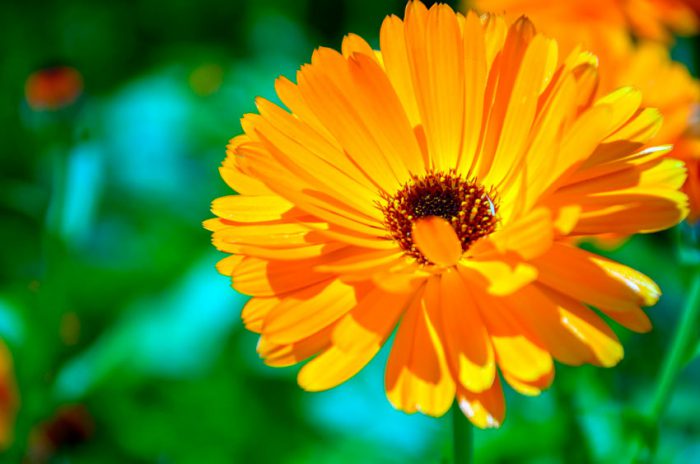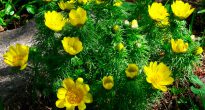Calendula (Calendula) is also called marigold. This herb belongs to the Aster family. In nature, marigolds can be found in Western Asia, in the Mediterranean, and also in Western Europe. The name of such a flower comes from the Latin word calendae, which means "the first day of the month." This genus unites about 20 plant species, among which there are both annuals and perennials. There are types (for example, medicinal marigolds) that are not only very beautiful, but also have healing properties. These properties were first mentioned by Dioscorides, who lived in the 1st century AD. e. and was an ancient Greek physician and philosopher. And also marigolds were used to create healing agents by Galen, Avicenna, Amirdovlat Amasiatsi and the famous herbalist Nicholas Kulpeper. Once, marigolds were used as a vegetable plant, so they were used to make wine, pudding, fillings for dumplings, and they were also put in oatmeal and soups. Such a plant was called a spice for the poor. The fact is that overseas spices were very expensive, and calendula could be an excellent substitute for saffron. She made the dishes more astringent and gave them an orangey-yellow hue. This plant has gained immense popularity in European countries. Shakespeare himself mentioned such a plant in his work, while the Queen of Navarre Marguerite Valois (Queen Margot) preferred marigolds to all other garden flowers.
Content
Features of calendula
Such a herbaceous plant has pubescence, which is a glandular fluff. Flowers can be yellow or orange. They are multi-flowered apical baskets, which include sterile tubular inner flowers (often darker in color) and outer pistillate fertile false-lingual flowers. Simple alternate oval leaf plates can be elongated or lanceolate. The fruits are achenes that can be curved or ring-shaped, and they are placed in 2 or 3 rows. Flowering begins in June and ends in November. A lot of seeds are formed, while they remain viable for 5 years.Marigolds have been cultivated as decorative flowers since the 16th century.
Growing calendula from seeds
Sowing in open ground
If you want to spend less effort, then you should sow seeds in open soil in April or October. In spring, sowing should be started after the soil, after the massive melting of the snow cover, dries out and warms up. To check the readiness of the soil for sowing a given plant, you need to collect a handful of soil in the garden and squeeze it in your fist, and then you need to throw it from a hundred centimeters high. If the soil is ready for sowing, then the lump should completely crumble. The soil must be prepared for sowing. So, about half a month before the scheduled sowing date, it will need to be dug up, while adding fertilizer. So, for 1 square meter, you should take 20 grams of potassium chloride and superphosphate, from 3 to 4 kilograms of humus and 30 grams of urea. However, experienced gardeners recommend doing this procedure in the autumn, only in this case, the nitrogen-containing fertilizer will have to be applied to the soil in the spring months. The seeds should be buried 10–20 mm into the soil. At the same time, a distance of 25 to 30 centimeters should be observed between the bushes, the distance between rows should be from 0.6 to 0.7 m.If such plants are grown as medicinal raw materials, then the distance between the bushes is made from 7 to 10 centimeters, and the row spacing should be between 0.3 and 0.4 meters. If everything is done correctly, the first seedlings will appear in 7 days. After 15–20 days after the first shoots appear, the plant will need to be thinned out, while a distance of at least 25–35 centimeters should be kept between the seedlings. Those seedlings that are superfluous can not be thrown away, but transplanted. The fact is that calendula tolerates transplants very well. Flowering will begin approximately 2.5 months after planting.
Sowing seedlings
The seedling method of growing marigolds helps to bring the moment of flowering closer. It is also recommended to grow undersized varieties by seedling. Sowing seeds should be done in the last days of March or the first in April. You can sow them both in individual cups and in a container, while using a flower potting soil mixture. The seeds should be buried only a couple of centimeters. The crops must be covered with foil and placed in a well-lit, warm (from 18 to 20 degrees) place, protected from direct sunlight.
How to care for seedlings
After the seedlings appear (usually after 6–8 days), the shelter must be removed and the containers must be moved to a place with a lower temperature (from 14 to 15 degrees). Such plants require timely watering and feeding once every half a month or in a decade, while using a weak solution of complex mineral fertilizer. When a pair of real leaves appear at the marigolds, they will need to be seated in individual containers or in a larger container, while maintaining a distance of 5 centimeters between the plants.
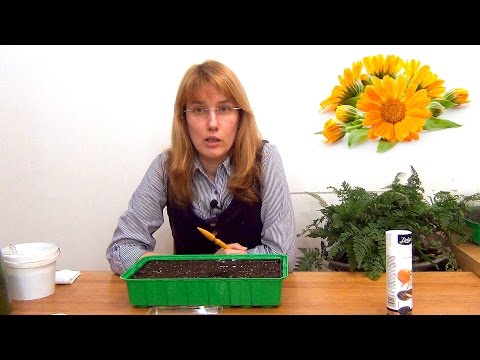

Watch this video on YouTube
Planting calendula in open ground
What time to plant
After the plants have 5 or 6 leaves, they should be transplanted into open soil. As a rule, this time falls on the second half of May. But it should be remembered that before planting, the seedlings will need to be hardened, and this is despite the fact that these flowers are quite winter-hardy and tolerate spring frosts well at night. To harden the plant, you need to transfer them every day for a short time to a covered terrace or balcony for seven days.
For planting, you need to choose an illuminated area, while the soil should be moist, well-drained and saturated with nutrients. Experienced gardeners try to plant such flowers in the aisles of other both garden and vegetable crops, which is a prevention against some harmful insects (ticks, butterflies with their larvae). At the same time, it is impossible to plant such a plant next to a basil or radish, since otherwise they will grow very slowly.
How to plant
It is necessary to plant seedlings in open soil using the same scheme as when sowing such a flower in the garden.So, between the bushes, you need to maintain a distance of 25 to 30 centimeters, and between the rows you need to leave a distance of 0.6 to 0.7 m. At the same time, for plants grown to create medicinal raw materials, a distance of 7–10 centimeters will be needed, while the row spacing should be between 0.3 and 0.4 meters. Plants begin to bloom after 40 to 50 days from the day of sowing the seeds.
This plant can reproduce independently by self-seeding.
Caring for calendula in the garden
It is very simple to take care of your nails. So, they need to be watered only during a period of prolonged drought, you should also loosen the surface of the site and remove weeds from it. Also, calendula requires feeding with complex mineral fertilizers once a month. But when growing such a flower, it should be remembered that after the position of the opened inflorescences becomes horizontal, all those flowers that have already been opened should be removed from the bush, this will allow the plant to bloom even longer and more magnificently. As a result, a lot of buds will appear, and the calendula will bloom for a long time. But at the same time, it is necessary to regularly cut off fully opened inflorescences. If you don't, the plants will bloom in the last days of July.
How to propagate
This plant is propagated exclusively by seeds.
Pests and diseases
It happens that these flowers are infected with powdery mildew or black spot. If specks of brown or black color appear on the leaf plates, this means that it is infected with black spot. In case of infection with powdery mildew, a whitish bloom appears on the shoots, leaf plates and flowers, which eventually becomes brown, the infected parts stop growing and change their color to black. The infected plant becomes less frost-resistant. You can get rid of such diseases by treating the infected bushes with fungicidal agents (Topaz, Topsin, Skor or Fundazol). Preventive measures:
- to thin out plantings in a timely manner;
- remove weeds in time;
- feed the flowers correctly, especially attention should be paid to nitrogen-containing fertilizers;
- remove plant residues from the site;
- make a deep digging of the site in the autumn;
- remember the rules of crop rotation;
- timely identify diseased bushes and remove them from the site.
Only aphids can settle on this flower, and other pests bypass it. Such a plant has one feature - it is able to attract all the aphids in the garden, which greatly facilitates the fight against such a pest. To destroy it, you should use such means as: Karbaphos, Fufanon, Aktellik, Antitlin, Akarin or Biotlin.
After flowering
Seed collection
The collection of seeds should be carried out after they are almost fully ripe. To prevent self-seeding, a small bag of gauze should be put on the wilted inflorescences, while fixing it on the stem.
Wintering
Marigolds are annuals, in this regard, after they stop blooming, the bushes need to be dug up and removed from the site.
Types and varieties of calendula with photos and names
Only 2 types of marigold are cultivated.
Field calendula (Calendula arvensis)
This species is not as popular as marigolds. The bushes grow up to 0.3 m in height. The flowers of such a plant are reed, while they are painted in an ocher-yellow color. Under natural conditions, such a plant can be found in wastelands, as well as in those areas that have been abandoned, located in the southern part of Europe. This plant must be grown in the same way as calendula officinalis.
Calendula officinalis (Calendula officinalis)
Or marigold, or pharmacy calendula, or pharmacy marigold, or balaban, or full crocon, or roast
This annual herb can reach a height of 0.2–0.75 meters. The ribbed pale green stems are rather thick, and there is a glandular, sticky pubescence on their surface.Simple sheet plates can be elongated or oval. On their surface, you can see rare very coarse hairs. Inflorescence baskets have a very pleasant smell that can invigorate. The inflorescences consist of orange or yellow reed flowers, which are glossy on top and matte on the bottom, and also of small tubular flowers that can be colored dark brown, yellow or orange. Flowering with proper care is quite long (from June to November). Differs in abundant fruiting. Breeders are constantly trying to develop new varieties, while their activities are divided into 2 areas: decorative and medical. American and European breeders are busy breeding more and more decorative forms. For example, there is a group of Pisific Beauty varieties, which is the shape of marigolds used for cutting, while the bush can reach 0.7 m in height, and the diameter of the baskets reaches 9 centimeters. There is also a group of Patio varieties, which is represented by plants of small size (about 0.3 m). And in the Kablun group there are varieties of anemic shape - their tubular flowers have grown relatively strongly.
The best decorative varieties include:
- Sonnenstein... The bush is quite compact and reaches a height of only 0.4 to 0.5 meters. Ribbed sturdy stems have a pale green color. Large oblong leaf plates are also pale green. Saturated yellow semi-double inflorescences have a diameter of 7.5 centimeters, while their reed flowers are twisted down.
- Juwel... A spherical bush in height can reach 0.4–0.5 meters. Its pale green shoots in cross-section have the shape of an irregular pentahedron. Pale green large and wide leaf plates are oblong in shape. The diameter of semi-double or double inflorescences is from 5 to 8 centimeters. They consist of yellow tubular flowers and flat reed flowers, painted in salmon orange color.
- Radio... In height, the bush can reach from 0.35 to 0.45 meters. The ribbed stems are quite powerful. Pale green large oblong leaf plates have embossed veins on their surface. Inflorescences can be semi-double and double, while they are hemispherical and reach 6-7 centimeters in diameter. The tubular flowers are orange-yellow, while the rich orange ligulate flowers are ½ part wrapped in a tube, at the base they have an orange-yellow color.
- Senseishen... The bush can reach a height of 0.45 meters. The leaf plates are dark green. The diameter of semi-double or double inflorescences is from 7 to 8 centimeters. They are composed of large glossy rich orange reed flowers, which are arranged in tiles, while the tubular flowers are yellow.
- Meistershtyuk... The height of the bush is about 0.45 m. The rich green leaf plates are rather large, elongated and expanding upward. The diameter of semi-double and terry baskets is from 6 to 8 centimeters. Their tubular flowers are pale brown, and the reed flowers are paddle-shaped, slightly concave and have a rich orange color.
Still especially popular are such varieties as: Orange Koenig, Gold Koenig, Gold Kugel, Canaryenfogel, Kabluna Gold, Calypso, Golden Emperor, etc.
Of the dosage forms, the most interesting are such varieties as: Kalta, Ryzhik, Sakharovskaya orange and others, which are created by Russian breeders.
Features of the properties of calendula
Useful properties of calendula
Marigolds, as a medicinal raw material, are grown on an industrial scale. In order to create medicines from this plant, it is necessary to collect inflorescences that have just begun to open. The fact is that they contain a lot of carotenoids (carotene, flavochrome, flavoxanthin, rubixanthin, lycolin, zigroxanthin), and they also contain aponin, paraffinic hydrocarbons, mucus, resins, phytoncides, bitterness, proteins, flavonoids, glycoside, apple , salicylic, pentadecyl and ascorbic acids and essential oil. The inflorescences of this plant have anti-inflammatory, antispasmodic, wound-healing and bactericidal effects. Such flowers are used to cure diseases of the internal organs and the nervous system.So, they are used as a diaphoretic, anesthetic, sedative, expectorant and tonic. Means prepared on the basis of this plant can lead to relaxation of the smooth muscle structures of the stomach, intestines, and also the liver, and this helps to increase bile secretion, bile formation, and also the secretory work of the stomach. Marigolds are able to effectively fight streptococci and staphylococci no worse than the most powerful antibiotic. However, this plant does not harm human health. In such diseases of the epidermis as psoriasis, allergic dermatoses, vitiligo, the products made from this plant should be used both for oral administration and for external use. An aqueous solution of calendula tincture is also actively used for tonsillitis, stomatitis, sore throat, and this remedy will also help reduce bleeding of the gums. This plant is also used to make an ointment that is used to treat cuts, bruises, burns, eczema and cracks on the skin surface. The oil of such a flower has proven to be effective for varicose veins, dry eczema, bedsores, and it can also be drunk for gastritis, stomach and duodenal ulcers, liver diseases, colitis, enterocolitis. Also, preparations based on calendula are used to eliminate nervousness in climacteric disorders and in neurasthenia.
This plant is also very often used as a cosmetic product. If you wash your hair with a mixture consisting of infusion of marigolds, hop cones and chamomile, then the hair will become more beautiful, and the hair and scalp will also heal.


Watch this video on YouTube
Contraindications
It should be remembered that the funds prepared on the basis of marigolds are forbidden to use:
- pregnant women;
- people with low blood pressure (blood pressure);
- with heart failure;
- in the presence of an individual intolerance to such a plant.
Be sure to check with your doctor before starting calendula treatment.

